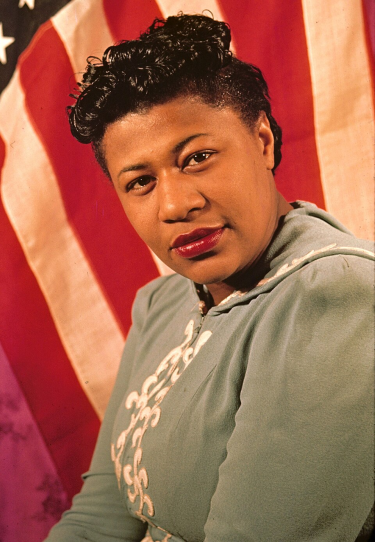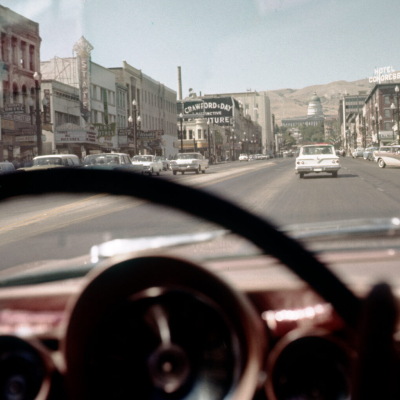An Online Story of Jazz in New Orleans
With an introduction by Nat Hentoff
__________
Featuring the complete text of chapters 1 – 5 from Hear Me Talkin’ To Ya: The Story of Jazz As Told By the Men Who Made It, a 1955 book by Nat Shapiro and Nat Hentoff
(Published with the consent of Nat Hentoff)
Chapter
*
Chapter 2
For every occasion – dances, funerals, parties, and parades
– there was a band and there were some mighty battles.
_____________
Among those featured in Chapter 2:
|
Louis Armstrong |
Wingy Manone |
Nat Towles |
Kid Ory |
|
Zutty Singleton |
Johnny St. Cyr |
Edmond Hall |
George Lewis |
_____________
|
New Orleans: Ragging Home, by Romare Bearden, _____
Flee as a Bird , by Louis Armstrong |
_____________
LOUIS ARMSTRONG
As many bands as you heard, that’s how many bands you heard playing right.
I thought I was in Heaven playing second trumpet in the
Tuxedo Brass Band – and they had some funeral marches that would just
touch your heart, they were so beautiful.
| DANNY BARKER
My grandfather worked for Emile Labat, the Creole section’s most successful
Now getting back to Joe Never Smile and the two horses.
Emile Labat would have raised hell as he was kind to |
Danny Barker, c. 1954 _____ Oh, Didn’t He Ramble, by the Preservation Hall Jazz Band |
|
A New Orleans marching brass band, 1950
*
|
As this observer recalls, in the days before they closed The District (which was 1917), the most exciting form of musical entertainment (aggregation) was not the jazz bands but the brass bands. The bass beat on the bass drum, beautifully executed by Black Benny, would suddenly silence a crowd of some seven or eight thousand loud and boisterous pleasure-seekers. All ears perked up for maybe a minute anxiously awaiting the lead trumpet to blow the three double-eighth note, ta-ta, ta-ta, ta-ta, signaling the band members who were scattered nearby, having wandered among the crowd. Characters like Bunk Johnson, Buddy Petit, Kid Rena, Frankie Duson, Chris Kelly, would be in the nearest barroom drinking – jiving some sporting women and drinking to everybody’s health, ruining his own. The bandmen who didn’t indulge would be coralled by groups of admirers and answering questions on the merits and playing abilities of the stars.
It was the greatest thrill of a kid to hold and watch
There were many funerals that had three or four bands
It was not rare to see funerals which had three or four
It was more than likely his request to be buried as he
On both occasions it was a sad sight to see their silent
The money earned (three or four dollars) for playing WINGY MANONE
On the way to the graveyard, they all walked slowly, following the cornet |
| NAT TOWLES
Yeah, that’s just the way it was in those days. You’d march to the graveyard
Oh, the brass bands might have had more men, two clarinets KID ORY
And during Mardi Gras – man! That’s when we really had fun. All day
The whites had an idea of a real king – he came |
Mardi Gras procession on Canal Street, 1900 *
Louis Armstrong (left) as King Zulu, 1949 _____ When the Saints Go Marching In, by Kid Ory
|
|
State Library of Louisiana
Dock workers, c. 1920’s _____ Station Calls , by Celestin’s Original Tuxedo Orchestra * © Louisiana State Museum
George McCullum, Barnum & Bailey’s Circus Band, 1909 _____ Weary Blues , by Bunk Johnson |
ZUTTY SINGLETON
There were so many bands in New Orleans. But most of the musicians had day
We played for society kids on Saturday afternoons – DANNY BARKER
Being a musician was not usually a full-time job in New Orleans. The musician
Some of the families were half-French and half-African.
So, if you were a musician, you had a regular trade, |
ALPHONSE PICOU
I was born in the year 1879. My father was a cigar maker and my mother was
a housewife.
As a boy, the first jazz I heard was a jazz band at the
corner of St. Phillips and Claiborne. It was called the Excelsior Band. The
only musician I remember from that band was Fice Quiyrit, the trumpet player.
It was a long time ago.
Was it ragtime? No, no, it was nothing but marches they
was playing – brass marches – parade music. I think the first ragtime
jazz band I ever heard was Boo Boo Fortunea. He was the only man at that
time who played the slide trombone. It was approximately – well, before
1900. I was still fifteen or sixteen years old then.
He played the trombone and he was a barber at that time.
He was living right around the corner from where I lived and he heard me
practicing my instrument and he came up to my house and knocked on the door.
My mother went to the door and she asked him what he wanted. He said, “I
would like to see that young man who is playing that instrument.” So she
said, “That’s my son.” He said, “Will you call him to the door?” And I went
to the door and he says to me, “Were you the one that was playing the clarinet?”
I says, “Yes.” He says, “Well, I’d like for you to come to my shop around
the corner because I want to talk to you.”
So I went to the shop and we had a talk and he said to
me, “Will you come here tonight and I would like to have you play with me
in my band.” I told him, “Of course, Okay.” He told me to be there at eight.
It was the first time that I ever played with a band. I was sixteen.
I had been taking lessons before that. I took lessons
for about eighteen months. My teacher’s name was Mr. Morand. He was a Creole.
|
Now let me finish telling you about the band. So I was
That was on a Thursday night, the rehearsal, and on the
Every number we played the people just clapped their
That particular style of playing without music was very
I remember when we got a new piece of music we would |
Alphonse Picou |
JOHNNY ST. CYR
A jazz musician have to be a working class of man, out
in the open all the time, healthy and strong. That’s what’s wrong today;
these new guys haven’t got the force. They don’t like to play all
night; they don’t think they can play unless they’re loaded. But a
working man have the power to play hot, whiskey or no whiskey. You
see, the average working man is very musical. Playing music for him is just
relaxing. He gets as much kick out of playing as other folks get out of dancing.
The more enthusiastic his audience is, why, the more spirit the working man’s
got to play. And with your natural feelings that way, you never make the
same thing twice. Every time you play a tune, new ideas come to mind and
you slip that on in.
|
Buddy Bolden
*
photo W.H. Leeson
Odd Fellows Hall _____ Nearer My God to Thee , by Baby Dodds Maryland, My Maryland , by Kid Ory |
DANNY BARKER
There was a variety of prices. In my day, you’d get about three dollars for
Everything in New Orleans was competitive. People would
Lots of the bands couldn’t read too much music. So they used a fiddle to
The marching brass bands used more instruments than the
I remember the Onward Brass Band had to play the marches for the Masonics
They played the shuffle beat on the snare drum and mostly |
| EDMOND HALL
As for why New Orleans was such a musical city and had so many bands, I think
One thing about funerals, by the way, that isn’t made
You could always make a living in New Orleans just playing
Louis Armstrong and Buddy played a lot of funerals together, |
Buddy Petit
*
Buddie Petit Jazz Band _____ Jelly Roll Morton talks about Funeral Marches |
|
Edmond Hall _____ High Society by Edmond Hall
|
In the very early days of brass bands, in the ‘nineties and even before, the music was mostly written – I mean in the kind of band my father played in. As time went on, there was more improvising.
I started on guitar, not clarinet, in 1917, when I was
The band came all the way from New Orleans just for that
In the brass band, on my own instrument they used to
There were five of us in my family, and when we got to
High Society was one of the testing pieces for |
ALPHONSE PICOU
I composed so many tunes. How did I happen to play High Society, the
famous chorus? Well, I was seventeen at the time. I was playing at that time
with John Robichaux, and before that I was playing with the Manuel Perez
band, and he used to get all that old-time music – what they’re asking
for right now.
He bought that High Society for me. It was a march
tune. We were at Mahogany Hall then. I took the piccolo part and transposed
it to my instrument. It made a wonderful hit. So the next night we had to
play at another hall where they had all the Creole meetings. At that time
they didn’t allow a dark man to come in. If you were dark you had to stay
out. I was there, and Manuel Perez liked the way I played High Society
and he says, “Come on in” – when a crowd was there – “Come
on and play High Society,” and they let me play that solo by myself.
I made a wonderful hit – Lord! They played High Society all night.
. .
I played parades with Manuel Perez and the Onward Brass
Band, also with Joe Oliver and Kid Rena. I played funerals too.
| KID ORY
I had a brass band too. When I got a job I’d supply any number of men they
They used to have “cutting contests” every time you’d
I used to say, “I’ll let you go when I think you should |
photo by George Fletcher
Kid Ory _____ Mutt’s Blues , by Kid Ory and his Creole Jazz Band |
|
A Carnival Group advertising the National Biscuit Company |
Cornelius Durkee Photograph Collection
Milk Cart, 1901 |
GEORGE LEWIS
We used to come to work or go on parades in big horse-drawn trucks, and when
two trucks met, there would be a “cutting contest.” One day we caught Buddy
(Petit) drunk, and our band really wore them out. The following Sunday we
drove up and we saw Buddy sitting there with his head hanging down and his
hands flopping, so we got set to go after them again. And then somebody sneaked
around and chained the wheel of our truck to theirs so we couldn’t get away,
and Buddy jumped to his feet, and that day they really wore us out!
WINGY MALONE
Down the street, in an old sideboard wagon, would come the jazz band from
one ballroom. And up the street, in another sideboard wagon, would come the
band from another ballroom, which had announced a dance for the same night
at the same price. And those musicians played for all their worth, because
the band that pleased the crowd more would be the one the whole crowd would
go to hear, and dance to, at its ballroom later that night.
At the back of the wagon were the trombone players, because
the only way they could handle their slides was over the end of the wagon.
And that’s how they got the name “tailgate” trombonists. They all played
a Dixieland “vamp” style, because there weren’t any room in the wagon for
fancy stuff.
BUNK JOHNSON
Bands in those days fighting all the time. One band get a job in the Love
and Charity Hall, another band move right over there and play better through
the windows. During Mardi Gras and parades, bands got taken around in wagons,
and they’d back them, tailgate to tailgate, and play each other down.
MUTT CAREY
If you couldn’t blow a man down with your horn, at least you could use it
to him alongside the head.
__________________________
An Online Story of Jazz in New Orleans
Chapter








































Excellent work here. You might also enjoy my JAZZ RHYTHM site about early jazz, full of streaming audio, photos, articles and original research.
http://www.JAZZHOTBigstep.com